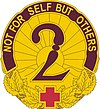| Revision as of 11:53, 8 March 2022 editLieutcoluseng (talk | contribs)Extended confirmed users55,801 editsm Fixing style/layout errors← Previous edit |
Revision as of 13:19, 8 March 2022 edit undoLieutcoluseng (talk | contribs)Extended confirmed users55,801 edits Expanding articleNext edit → |
| Line 33: |
Line 33: |
|
==Organ donation== |
|
==Organ donation== |
|
LRMC is one of the top hospitals for organ donations in its region in Europe. Roughly half of the American military personnel who died at the hospital from combat injuries from 2005 through 2010 were organ donors. That was the first year the U.S. Armed Forces allowed organs to be donated by military personnel who died at the hospital from wounds suffered in Iraq or Afghanistan. From 2005 through 2010, 34 donated a total of 142 organs, according to the organ transplant organization, ''Deutsche Stiftung Organtransplantation'' ({{lang-en|German Organ Transplantation Foundation}}).<ref>{{cite web |last=Jones |first=Meg |title=A Soldier's Death Gives Life to Another Man|url=http://pulitzercenter.org/articles/germany-us-hospital-landstuhl-organ-donations |work=Milwaukee Journal Sentinel}}</ref> |
|
LRMC is one of the top hospitals for organ donations in its region in Europe. Roughly half of the American military personnel who died at the hospital from combat injuries from 2005 through 2010 were organ donors. That was the first year the U.S. Armed Forces allowed organs to be donated by military personnel who died at the hospital from wounds suffered in Iraq or Afghanistan. From 2005 through 2010, 34 donated a total of 142 organs, according to the organ transplant organization, ''Deutsche Stiftung Organtransplantation'' ({{lang-en|German Organ Transplantation Foundation}}).<ref>{{cite web |last=Jones |first=Meg |title=A Soldier's Death Gives Life to Another Man|url=http://pulitzercenter.org/articles/germany-us-hospital-landstuhl-organ-donations |work=Milwaukee Journal Sentinel}}</ref> |
|
|
|
|
|
==Decorations== |
|
|
{|class=wikitable |
|
|
! Streamer |
|
|
! Award |
|
|
! Period of service |
|
|
! Reason: |
|
|
|- |
|
|
||] |
|
|
||] |
|
|
||September 11, 2001 to September 11, 2003 |
|
|
|| For exceptionally meritorious service. |
|
|
|} |
|
|
|
|
|
==See also==<!-- EDITORS NOTE: This section should primarily contain lists linked to the main article which are directly related to the hospital. Thank you. --> |
|
==See also==<!-- EDITORS NOTE: This section should primarily contain lists linked to the main article which are directly related to the hospital. Thank you. --> |
Opened on March 9, 1953, LRMC was formerly known as the 2d General Hospital and the Landstuhl Army Medical Center (LAMC). In 1980, soldiers who were injured in Operation Eagle Claw were brought to LAMC. During the 1990s, U.S. Army Europe underwent a reorganization, and hospitals in Frankfurt, Berlin, Nuremberg, and other bases were gradually closed down, or were downsized to clinics. In 1993, a group of 288 U.S. Air Force personnel augmented the hospital. By 1997, it was the only U.S. medical center in Europe.
LRMC is one of the top hospitals for organ donations in its region in Europe. Roughly half of the American military personnel who died at the hospital from combat injuries from 2005 through 2010 were organ donors. That was the first year the U.S. Armed Forces allowed organs to be donated by military personnel who died at the hospital from wounds suffered in Iraq or Afghanistan. From 2005 through 2010, 34 donated a total of 142 organs, according to the organ transplant organization, Deutsche Stiftung Organtransplantation (Template:Lang-en).

 Aerial view of Landstuhl Regional Medical Center
Aerial view of Landstuhl Regional Medical Center

 Media related to Landstuhl Regional Medical Center at Wikimedia Commons
Media related to Landstuhl Regional Medical Center at Wikimedia Commons